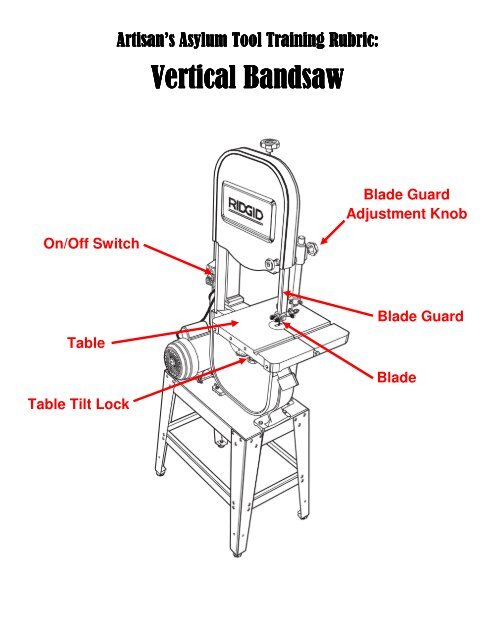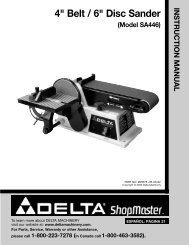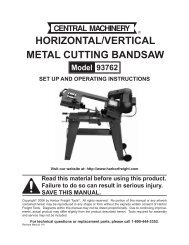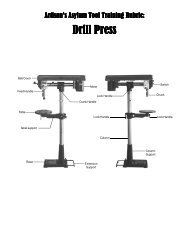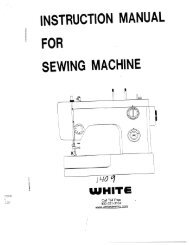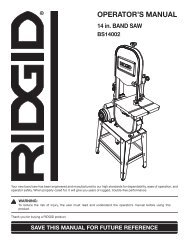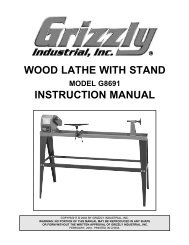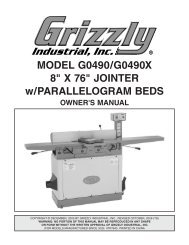Vertical Bandsaw Vertical Bandsaw - This Wiki
Vertical Bandsaw Vertical Bandsaw - This Wiki
Vertical Bandsaw Vertical Bandsaw - This Wiki
Create successful ePaper yourself
Turn your PDF publications into a flip-book with our unique Google optimized e-Paper software.
Artisan’s Asylum Tool Training Rubric:<br />
<strong>Vertical</strong> <strong>Bandsaw</strong><br />
On/Off Switch<br />
Blade Guard<br />
Adjustment Knob<br />
Blade Guard<br />
Table<br />
Blade<br />
Table Tilt Lock
Personal Protective Equipment<br />
• Standard shop personal protective equipment (safety glasses, no long hair, no<br />
flowing clothes, etc.) are required<br />
• ABSOLUTELY NO gloves, rings, bracelets, or other items on your hands or<br />
fingers, as these may get sucked into the saw blade<br />
• An attached vacuum is required for bandsaws used in the woodshop<br />
Safe Operation<br />
• Always cut workpieces that are resting on the worktable – no ‘free hand’ cutting<br />
of work in air<br />
• Adjust the blade guard to cover the blade down to ¼” above the work to be cut<br />
• DO NOT attempt to clear the blade of loose pieces while the machine is running.<br />
Only clear the blade and table of loose pieces of lumber after the blade has come<br />
to a complete stop<br />
• If the saw starts slowing down or making excessive noise, reduce cut pressure<br />
and/or cut turning radius<br />
• Clamp all round pieces to V-blocks or miter gauges before attempting to cut them<br />
on a bandsaw, to prevent them from rolling<br />
• Push workpieces through the saw by applying pressure on both sides of the<br />
workpiece. Use miter gauges or push sticks to guide material through the<br />
bandsaw on the side closest to the blade<br />
• DO NOT push on the workpiece along the bandsaw’s line of cut<br />
• Adjust the tilt of the table by loosening the table tilt lock, tilting the table to the<br />
desired angle, and tightening the table tilt lock<br />
Common Maintenance Operations<br />
• None. Please see an instructor or a staff member if a blade breaks or jumps off<br />
the drive wheels, or if you need to install a new blade. Do not attempt to service<br />
the blade yourself<br />
Allowable Materials<br />
• Allowable materials are dependent on the shop the bandsaw is in; only wood is<br />
allowed in the wood shop, while plastic and metals are allowed in the metal shop<br />
• Cut wood must comply with the following rules:<br />
o No moldy or wet wood<br />
o No treated/painted/finished wood<br />
o All nails and staples removed<br />
o All hardwoods must be checked against a cutting/sanding chart for<br />
hazardous dust reactions
Artisan’s Asylum Tool Training Test:<br />
<strong>Vertical</strong> <strong>Bandsaw</strong><br />
Student’s Name:<br />
Instructor’s Name:<br />
Date of Test:<br />
____________________________<br />
____________________________<br />
____/____/____<br />
Point out the following tool features:<br />
[ ] On/Off Switch<br />
[ ] Table<br />
[ ] Table Tilt Lock<br />
[ ] Blade Guard Adjustment Knob<br />
[ ] Blade Guard<br />
[ ] Blade<br />
Personal Protective Equipment:<br />
1. Can work gloves be worn while using a bandsaw? ( Yes / No )<br />
Safe Operation:<br />
1. Demonstrate the correct amount of clearance the blade guard needs off the top<br />
of the workpiece<br />
2. Demonstrate safe cutting procedures on a number of different sizes of workpiece<br />
3. What are two proper courses of action to take if the saw starts slowing down?<br />
Common Maintenance:<br />
1. What do you do if a blade jumps off the bandsaw’s drive wheels?<br />
Allowable Materials:<br />
1. State 3 requirements of the wood that is cut on wood shop bandsaws<br />
Passed: YES / NO<br />
Instructor’s Signature:<br />
____________________________


